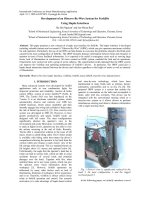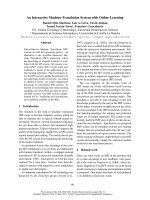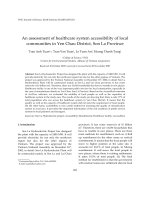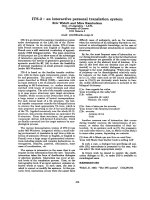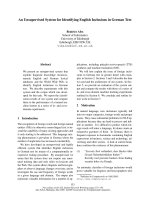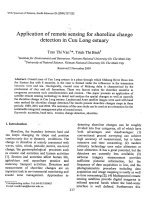Developing an interactive voice response system for behavioral change communication in ethiopia
Bạn đang xem bản rút gọn của tài liệu. Xem và tải ngay bản đầy đủ của tài liệu tại đây (1.53 MB, 99 trang )
Addis Ababa University
School of Information Science and School of Public Health
Developing an Interactive Voice Response System for
behavioral change communication in Ethiopia
By
Abenezer Tsegaye
June, 2017
Advisors
Dr. Dereje Teferi
Dr. Eshetu Girma
A Thesis Submitted to the School of Graduate Studies of
Addis Ababa University in Partial Fulfillment of the
Requirements for the Degree of Master of Science in Health
Informatics
i
Affiliation: Addis Ababa University
School of Information Science and School of Public Health
Programme: M.Sc in Health Informatics
Project Title: Developing an Interactive Voice Response System for
behavioral change communication in Ethiopia.
Student: Abenezer Tsegaye
Date: June, 2017
Approval
Dr. Dereje Teferi
Name
_______________
Date
______________
Signature
Dr. Eshetu Girma
Name
_______________
Date
______________
Signature
________________
Name
_______________
Date
______________
Signature
________________
Name
_______________
Date
______________
Signature
ii
DEDICATION
This thesis is dedicated to my mother Samrawit Tesfaye.
iii
ACKNOWLEDGEMENT
First of all, I would like to thank Almighty God for giving me the patience, wisdom, knowledge
and strength I needed to complete this study and for always guiding me in every phase of my
life.
I would like to express my gratitude and heartfelt thanks to my advisors Dr. Eshetu Girma and
Dr. Dereje Teferi for their guidance and kindness throughout this thesis.
Last but not least, my special thanks go to my beloved family and friends who supported and
encouraged me throughout my study.
iv
List of Contents
ACRONYMS .................................................................................................................................. x
Executive Summary ....................................................................................................................... xi
CHAPTER ONE: INTRODUCTION ........................................................................................... 12
1.1.
Background .................................................................................................................... 12
1.2.
Statement of the Problem ............................................................................................... 14
1.3.
Objectives of the Project ................................................................................................ 16
1.3.1.
General Objectives .................................................................................................. 16
1.3.2.
Specific Objectives ................................................................................................. 16
1.4.
Scope and limitation of the System ................................................................................ 17
1.5.
Significance of the System ............................................................................................. 17
1.6.
Organization of the Project ............................................................................................ 18
CHAPTER TWO: LITERATURE REVIEW AND RELATED WORK ..................................... 19
2.1.
Overview ........................................................................................................................ 19
2.2.
Health Education, Health Promotion and Behavioral Change Communications........... 20
2.4.
Behavioral Change Communication and Information Communication Methods .......... 22
2.5.
Talk-lines with respect to Ethiopia................................................................................. 23
2.6.
Interactive Voice Response (IVR) Systems ................................................................... 24
2.7.
Related Works ................................................................................................................ 26
2.8.
Conceptual Framework .................................................................................................. 28
CHAPTER THREE: METHODOLOGY ..................................................................................... 29
3.1.
Study Period and Area.................................................................................................... 29
3.2.
Study Design .................................................................................................................. 29
3.3.
Source and Sample Population....................................................................................... 29
3.4.
Sample Size .................................................................................................................... 30
3.5.
Data Collection Instruments ........................................................................................... 30
3.6.
System Development...................................................................................................... 31
3.7.
System Evaluation .......................................................................................................... 31
3.8.
Tools and Techniques..................................................................................................... 32
3.9.
Operational Definitions .................................................................................................. 34
3.10.
Ethical Consideration ................................................................................................. 34
v
3.11.
Result Dissemination .................................................................................................. 35
CHAPTER FOUR: SYSTEM ANALYSIS .................................................................................. 36
4.1.
Overview ........................................................................................................................ 36
4.2.
The Existing System....................................................................................................... 37
4.2.1.
Gaps in the existing system..................................................................................... 38
4.3.
The Proposed System ..................................................................................................... 40
4.4.
Functional Requirements................................................................................................ 41
4.5.
Non-functional Requirements ........................................................................................ 42
4.5.1.
User friendliness ..................................................................................................... 42
4.5.2.
Accessibility............................................................................................................ 42
4.5.3.
Portability................................................................................................................ 42
4.5.4.
Security ................................................................................................................... 42
4.5.5.
Reliability................................................................................................................ 43
4.5.6.
Performance and Speed........................................................................................... 43
4.5.7.
Customer satisfaction .............................................................................................. 43
4.6.
System Models ............................................................................................................... 43
4.6.1.
Use Case Diagram................................................................................................... 44
4.6.2.
Actor Definitions .................................................................................................... 45
4.6.3.
Use Case Descriptions ............................................................................................ 46
4.6.4.
Class Diagram ......................................................................................................... 56
4.6.5.
Activity Diagrams ................................................................................................... 57
4.6.6.
Sequence Diagrams ................................................................................................. 59
CHAPTER FIVE: SYSTEM DESIGN ......................................................................................... 63
5.1.
Design Goals .................................................................................................................. 63
5.1.1.
Performance ............................................................................................................ 63
5.1.2.
Dependability .......................................................................................................... 63
5.1.3.
Cost ......................................................................................................................... 64
5.1.4.
Maintainability ........................................................................................................ 64
5.1.5.
Usability .................................................................................................................. 64
5.2.
Tradeoffs ........................................................................................................................ 65
5.3.
System Architecture ....................................................................................................... 66
5.4.
Sub-System Decomposition ........................................................................................... 67
vi
5.5.
Interface and IVR Menu ................................................................................................. 67
5.5.1.
Interface .................................................................................................................. 67
5.5.2.
IVR Menu ............................................................................................................... 69
5.6.
Hardware/Software Mapping ......................................................................................... 70
CHAPTER SIX: IMPLEMENTATION AND EVALUATION OF THE SYSTEM ................... 71
6.1.
Implementation of the system ........................................................................................ 71
6.1.1.
System Development Tools .................................................................................... 71
6.1.2.
Prototype ................................................................................................................. 73
6.2.
System Evaluation .......................................................................................................... 77
6.2.1.
Overview ................................................................................................................. 77
6.2.2.
Usability Testing Methodology .............................................................................. 78
6.2.3.
Usability Test Participants ...................................................................................... 78
6.2.4.
Usability Test Training ........................................................................................... 78
6.2.5.
Usability Test Procedure ......................................................................................... 78
6.2.6.
Usability Test Roles ................................................................................................ 79
6.2.7.
Usability Test Goals ................................................................................................ 79
6.2.8.
Usability Test Tasks ................................................................................................ 80
6.2.9.
Test Results and Conclusion ................................................................................... 81
CHAPTER SEVEN: CONCLUSION AND FUTURE WORKS ................................................. 84
7.1. Conclusion.......................................................................................................................... 84
7.2.
Future Works .................................................................................................................. 85
REFERENCES ............................................................................................................................. 86
ANNEX......................................................................................................................................... 89
Annex A: Requirement collection Discussion guide 1 ............................................................. 89
Annex B: Requirement collection Discussion guide 2, for health professionals ...................... 90
Annex C: Usability Test Questionnaire .................................................................................... 91
Annex D: Informed Consent ..................................................................................................... 92
Annex E: English IVR Menu .................................................................................................... 93
Annex F: Declaration ................................................................................................................ 99
vii
List of Figures
Figure 1: Mobile cellular subscribers in Ethiopia both rural and urban, Source Trading
Economics (2014) ......................................................................................................................... 20
Figure 2: Conceptual framework of the BCC-IVR ....................................................................... 28
Figure 3: Use Case Diagram for the BCC-IVR system ................................................................ 45
Figure 4: Class Diagram for the BCC-IVR system ...................................................................... 57
Figure 5: Activity Diagram for Listening BCC message.............................................................. 58
Figure 6: Activity Diagram for View Call Records ...................................................................... 59
Figure 7: Sequence Diagram for Listen to BCC Message ............................................................ 60
Figure 8: Sequence Diagram for Start Server ............................................................................... 61
Figure 9: Sequence Diagram for View Call Records.................................................................... 62
Figure 10: System Architecture .................................................................................................... 66
Figure 11: Subsystem Decomposition .......................................................................................... 67
Figure 12: Standard Touch-Tone Dial (Key pad) ......................................................................... 68
Figure 13: Voice Menu Tree of the BCC-IVR system ................................................................. 69
Figure 14: Hardware/Software Mapping ...................................................................................... 70
Figure 15: BCC-IVR administration page .................................................................................... 74
Figure 16: Zoiper Soft Phone ........................................................................................................ 75
Figure 17: Asterisk Server ............................................................................................................ 76
Figure 18: Audacity, audio recording and editing software ......................................................... 76
Figure 19: Asterisk Server, Call in progress ................................................................................. 77
Figure 20: Usability test results, source evaluation survey of the BCC-IVR system 2017 ......... 82
viii
List of Tables
Table 1: Summary of Techniques and Tools used in the project .................................................. 33
Table 2: Summary of participants’ in the requirement analysis ................................................... 37
Table 4: Description for Call-in .................................................................................................... 46
Table 5: Description for Insert Input ............................................................................................ 47
Table 6: Description for Select Language .................................................................................... 48
Table 7: Description for Record Voice Input ............................................................................... 49
Table 8: Description for Terminate call ........................................................................................ 50
Table 9: Description for Login ..................................................................................................... 51
Table 10: Description for Listen to BCC message ....................................................................... 52
Table 11: Description for Hold call .............................................................................................. 53
Table 12: Description for View CDR ........................................................................................... 54
Table 13: Description for Start server ........................................................................................... 55
Table 14: Description for Stop Server .......................................................................................... 56
Table 15: Usability test participants ............................................................................................. 78
Table 16: Usability test task .......................................................................................................... 80
Table 17: Usability test interview results, source evaluation survey of the BCC-IVR system 2017
....................................................................................................................................................... 82
ix
ACRONYMS
BCC-IVR
Behavioral Change Communication Interactive Voice Response
DTMF
Dual Tone Multi-Frequency
ETC
Ethiopia Telecommunication Corporation
FMOH
Federal Ministry of Health
HEP
Health Extension Program
IBCTs
Interactive Behavioral Change Technologies
IVR
Interactive Voice response
MDB
Major Disease Burden
MHB
Major Health Burden
PMTCT
Preventing Mother to Child Transmission
PSTN
Public Switched Telephone Network
SMS
Short Messaging Service
TB
Tuberculosis
UHF
Ultra High Frequency
UML
Unified Modeling Language
VHF
Very High Frequency
VOIP
Voice over IP
WHO
World Health Organization
x
Executive Summary
Background: Ethiopia is undergoing a heavy health care burden, mainly attributed to
communicable diseases and nutritional deficiencies. The Federal Ministry of Health aims to
improve health through the Health Extension Program (HEP). On the other hand, the number of
mobile phone subscribers in Ethiopia has shown a significant increase. The use of voice message
can deliver the kind of universal access, including the portion of population that doesn’t know how
to read, to support prevention services.
Interactive Voice Response (IVR) is a phone system technology that allows a computer to interact
with humans by using pre-recorded or computer generated voice responses via Dual Tone MultiFrequency (DTMF) signal.
Objective: The main objective of the project is developing and testing the BCC-IVR system to
improve health outcomes of selected major health problems in Ethiopia.
Methodology: The requirement collection used guided discussion with 25 participants, 12
residents and 13 health care professionals and document review. After data collection, functional
and nonfunctional requirements were identified and analyzed using UML’s Use Case diagram,
Class diagram, Activity diagram and Sequence diagram.
Implementation: During implementation this project the prototype has shown how to create the
services in Asterisk. The flow of BCC-IVR system is implemented in the dial plan and the user
interacts by using telephone keypad with the asterisk server. The IVR system has a three-tier
architecture model made up of presentation, application/logic, and storage layers.
After implementation, the BCC-IVR system is evaluated by 9 English and Amharic speakers to
identify and correct functionality issues and ensure usability.
Result: The result of this project is a Behavioral Change Communication Interactive Voice
Response system accessible from any phone under the same network. The resulting BCC-IVR
system includes information on Reproductive care, Sanitation and environmental hygiene,
Nutrition, Cancer and Periodical Screening and treatment and First-Aid. The information on the
health topics is presented in English and Amharic Languages.
Conclusion: Universal access is the important while providing information. People should be able
to choose the access method that suits them. Literate people might still be more comfortable with
written information, but the need for voice information is also there, mainly for illiterate and
visually impaired people. The IVR system is accessible, helpful, inexpensive to implement and
easy to learn tool to deliver Behavioral Change Communication Messages.
xi
CHAPTER ONE: INTRODUCTION
1.1. Background
Ethiopia is a Federal Democratic Republic country with 11 regions, 9 regional states and two city
administrations, totally containing 805 districts. Ethiopia is also the second largest county among
the sub-Saharan Africa. As of now, the record for the total amount of population in the country is
more than 90 million [1].
Almost 80% of the Ethiopian residents are living in the rural areas of the country and 51.9 % of
the total population does not know how to read and write in ways that are present in books and
other educational tools [2]. This means, more than half of typical population of the country have
to get their health information elsewhere, not through reading.
Ethiopia currently experiences a heavy health care burden, mainly attributed to avoidable causes
like communicable diseases and nutritional deficiencies. The country is also progressively facing
the burden of chronic health problems such as cardiovascular diseases, diabetes and cancer. When
injuries are added on top of that, the triple burden the country is facing manifests. Shortage and
high turnover of health professionals and inadequacy of essential drugs and supplies have also
contributed to the problem [3].
Ethiopia has a three-tier health care delivery system to fight these health problems. The system is
characterized by a first level of Woreda /district health care delivery system comprising a primary
hospital, with population coverage of 60,000 to 100,000 people, health centers serving 15,000 to
25,000 residents, and their satellite health posts covering 3,000 to 5,000 people. A primary hospital
and each health center with their five satellite health posts form a Primary Health Care Unit
(PHCU). On the second level, the tier is made up of a general hospitals with population coverage
of 1.5 million people, and the third tier level specialized hospitals serve a population of 3 to 5.5
million [4].
The Federal Ministry of Health aims to increase the results through the Health Extension Program
(HEP). The HEP is designed to deliver health promotion, immunization and other disease
prevention measures along with a limited number of high-impact curative interventions [5].
12
However, primary care physicians and health care delivery systems face substantial challenges to
provide preventive services. First, Preventive Care and Counseling is time consuming when done
face to face. Second, it is not affordable or feasible to implement a hundred percent face to face
approach even in, highly resourceful, developed countries. Therefore, prevention should be
supported by activities other than face to face encounter by using information delivery methods,
given they are found beneficial and accessible [6].
Today e-Health, the use of ICTs to facilitate heath care and service delivery, presents a unique
opportunity for the development of the health sector. In Ethiopia, the Federal Ministry of Health
(FMOH) has recognized the benefits of Information and Communication Technology (ICT) as a
tool to support the health sector [7].
Within ICTs, portable technology through the use of mobile devices is by far the fastest growing
segment in Ethiopia. Currently, the country has more than 40 million mobile subscribers and plans
to raise the number up to 64 million in GTP II period [8].
In developing countries, lack of facilities, equipment, and health care professionals mean that
many people do not have appropriate access to care providers and medical facilities. This is
especially true for those living in remote rural areas. mHealth initiatives are effective in reaching
those populations, changing health behaviors and outcomes, and addressing a wide variety of
healthcare challenges. Therefore, they are preferable to implement in Ethiopia, a country where
almost 80% of the population lives in rural areas.
mHealth projects’ implementation can use Text messages, Voice messages and Internet for
information exchange and data collection. In a country where more than half of the population
don’t know how to read and write, voice is the best way to deliver messages.
In the vicinity of voice messages, Interactive voice response (IVR) systems, a rapidly expanding
technology for automated acquisition and dispersal of information represent the convergence of
computer-automated interviewing with touchtone telephone service. IVR systems are applicable
in numerous areas. Its applications for routing telephone calls or accessing banking services are
now commonplace. Potential benefits of IVR systems for clinical research and treatment have
recently begun to be explored and realized [8].
13
Secured IVR systems protect confidentiality by unique personal identification numbers and
passwords, patients interacting with IVR systems provide information that is used to tailor their
current and future interactions. This type of interaction may be most beneficial in treating
frequently occurring behaviors that intrude on daily life, such as hygiene, nutrition, substance use,
sexual behaviors, obsessive-compulsive behaviors, depression etc. [9].
1.2. Statement of the Problem
Over the last decades, Ethiopia has successfully implemented strategies to expand and rehabilitate
primary health care facilities. The country also scaled up investments in human resource
development and management. Although good trends are observed, the country is still facing a
triple burden of diseases consisting of communicable diseases, non-communicable diseases and
injuries [7].
The progress in health status of the Ethiopian population indicates that about 80% of diseases in
Ethiopia are attributable to preventable conditions related to infectious diseases, malnutrition; and
personal and environmental hygiene. Also, environmental risk factors contribute to 31% of the
total disease burden in the country [10]. In line with WHO and FMOH strategic plans, this project
focuses on the problem areas explained bellow.
Reproductive care
Reproductive health care in Ethiopia is generally poor, with significant regional disparities in
access to services and in health outcomes. In the country gender inequality, sexual coercion, early
sexual debut, unwanted/ unplanned adolescence pregnancy, abortion, Sexually Transmitted
Infections and HIV/AIDS are the major sexual and reproductive health problems [11].
In Ethiopia, the youth has a disadvantaged access to sexual and reproductive health information
and services. There are residents of the country with avoidable yet highly risky behaviors regarding
reproductive health. There is high number of unwanted pregnancies, indicating low level of Family
planning [12].
14
HIV/AIDS incidence rate has shown a declining trend in Ethiopia, currently at 0.29%, but the
country’s large population means there are nearly 1.2 million residents living with HIV/AIDS. The
disease is still a major reproductive health burden [13].
Environmental Hygiene and Sanitation
Estimates based on national exposure and WHO country health statistics in 2004 shows 112,100
deaths each year from water, sanitation and hygiene related causes in Ethiopia [10]. This means
the promotion of hygiene and sanitation through the health extension program should be
strengthened.
Open defecation is also a big problem in the country; promotion is needed to structure open
defecation free villages. FMOH plans to implement a national sanitation marketing strategy to
generate demand and create access to supplies for construction of improved latrines [7].
Nutrition
Worldwide, malnutrition is an underlying cause in the deaths of more than 3.5 million children
under the age of 5 each year. 13 million infants are born each year with low birth weight (LBW),
55 million children are wasted, and of these 19 million are severely wasted. About 178 million
children around the world are stunted and 90 percent of these estimated number live in 36
countries, one of which is Ethiopia [14].
First Aid
In Ethiopia, Health Information communication methods include house to house visits, dialogues,
discussions, mass-media, and entertaining plays, none of which are easily accessible on and
according to demand of the information [15].
Ethiopian Red Cross has an android application, available on the World Wide Web for free, to be
used for smart phones, but people who can’t read and people without a smart phone don’t have a
way to access that helpful information.
The problems mentioned above coupled with quite a few others make up what is known as triple
burden of health care in Ethiopia. The procedures taken by the government include, increasing
government expenditure, providing free care, and searching for other financing sources for
15
sustainable financial option [7]. But all this effort; though progressive, is not nearly sufficient for
getting rid of accessibility, quality and equity problems in the country.
Since, the majority of diseases in Ethiopia are attributable to preventable conditions and
information is an important input for preventive interventions. The BCC-IVR system is designed
to easily deliver information on selected conditions aiming to decrease the impact with informed
decisions. The BCC-IVR system’s purpose is to reduce the financial burden associated with
computer, internet, or “smart phone” accessibility, literacy and financial restrictions on access to
simple health information.
In conclusion, Ethiopia needs to overcome poor health care seeking behavior trend, information
unavailability and the destructive ignorance towards avoidable health problems. Easy access to
information has a major impact on health promotion and is also an important input for making
healthier decisions. Typical residents of Ethiopia get health care information from government
providers, but the need is greater than the resources and Health promotion can be a potential
remedy to these problems. The project aims to develop an Interactive Voice Response System for
delivering behavioral change communication messages.
1.3. Objectives of the Project
1.3.1. General Objectives
The main objective of the project is developing and testing an Interactive Behavioral Change
Communication Voice Response system in English and Amharic to ease access to health
information in the selected domains.
1.3.2. Specific Objectives
The specific objectives of the system are: Selecting and categorizing dominant health problems to Behavioral Change
Communication messages using guidelines and guided discussions as tools.
Designing easily navigable and Interactive Voice Response Menu tree.
16
Implementing and Evaluating the Behavioral Change Communication Interactive Voice
Response System prototype.
1.4. Scope and limitation of the System
The BCC-IVR system, to help preventive intervention message delivery, is developed using the
local language “Amharic” for the first prototype. The system delivers only important, relevant and
brief messages on prevention practices for typical residents. Currently, the system doesn’t have
dependency on clinic-based care.
The system includes brief BCC messages on the following five major areas: Preventive sexual and reproductive care recommendations- Including Family Planning
options and HIV/AIDS
Sanitation and environmental hygiene dos and don’ts
Nutritional facts
Screening and treatment (Cancer and Periodical)
First-Aid
Limitations of the system
•
The IVR system is using only one local language, Amharic.
•
The BCC-IVR doesn’t have a Patient centric follow up.
•
The IVR system doesn’t include targeted messages from Health Professionals.
•
Inadequate funding, because the project was sponsored by the student.
The IVR system can be applied using multiple local languages in the future and also other areas
such as, Therapeutic smoking and drinking cessation, Patient centric follow up, Health Extension
Workers assistance and others (see future works).
1.5. Significance of the System
The proposed BCC-IVR system improves information accessibility and narrows the gap in health
promotion of selected health care issues in line with at least three of Ethiopian development goals.
17
The benefits of the system are:
Delivering health promotion and preventive care advices timely 24/7.
Providing better information for better decision making.
Improving health care seeking behavior trend by pointing out symptoms and warnings for
the uninformed part of the population.
No transportation cost and time loss to get simple medical advices.
Knowledge dissemination to decrease impact of particular avoidable health problems.
Provide low cost implementation choice for preventive care.
1.6. Organization of the Project
This project report is organized as follows: Chapter 1 is an introduction to the problem area and
the proposed solution. Chapter 2 discusses general literature and related works parallel to
Interactive Voice Response systems (IVRs) and Behavioral Change Communications (BCCs).
Chapter 3 includes all the methodologies, tools and techniques used to put together this project.
Chapter 4 discusses system analysis and conceptual model of the development. Chapter 5
illustrates all the concerns, goals and remedies regarding system design and Chapter 6
demonstrates the implementation and evaluation of the BCC-IVR prototype system. The final
section, Chapter 7 discusses conclusions, and recommendations for future works.
18
CHAPTER TWO: LITERATURE REVIEW AND RELATED WORK
2.1. Overview
Ethiopia is a poor country with weak health care infrastructures and uneven access to health care
services. Ranking 92 out of 95 on the UNDP Human Poverty Index, Ethiopia is one of Africa’s
poorest states, with 45% of its people living below the poverty line [16]. Three-quarters of the
population lack access to clean water, and four persons out of five live without proper sanitation.
In addition, Ethiopia hosts sum of 133,000 refugees from neighboring countries [16].
Poor health coverage is of particular concern in rural Ethiopia and access to any type of modern
health institution is limited at best. In the last two decades, major crises combining droughts,
epidemics, displacements and armed conflicts have repeatedly affected the country. Health
systems and roads are underdeveloped, and transportation problems are severe, especially during
the rainy season. The diversity of socio-economic environments, climates, and terrains among
regions of Ethiopia also has an impact on health conditions and outcomes [17].
In the absence of a strong health care infrastructure, prevention and promotion are the most
efficient towards improvement of health outcomes. The health policy of the Federal Democratic
republic of Ethiopia has given due emphasis to promote preventive interventions coupled with
basic curative services [7]. And, the recent progress shows, almost 80 percent of morbidity in
Ethiopia is credited to preventable communicable and nutritional diseases, both associated with
low socio-economic development [10].
In Ethiopia, most of the population lives in rural areas and only 49.1% of the residents are literate
enough to read. Absence of sufficient budget by is one of both the causes and effects regarding
illiteracy [2]. Therefore; any health promotion system of Ethiopia has to be cheap, inclusive
towards low literacy groups and easily accessible for different groups in order to be successfully
implemented in this country.
Historically, mHealth initiatives were expensive and backed up by inadequate infrastructure to
implement in African and even more so in sub-Saharan countries. But; recently the increasing
number of phones due to various market reasons makes the means especially appealing for
countries like Ethiopia. Figure 1 shows the significant increase in the number of both urban and
19
rural area mobile subscribers and to demonstrate the opportunity for Ethiopian mHealth initiatives
in health care.
Figure 1: Mobile cellular subscribers in Ethiopia both rural and urban, Source Trading Economics (2014)
The Behavioral Change messages in the BCC-IVR system are delivered through voice calls. The
health topics of choice for the project are Reproductive care, Sanitation and Environmental
hygiene, Nutrition, Maternal and Child Health, and First-Aid for purposes and limitations
discussed in chapter one.
2.2. Health Education, Health Promotion and Behavioral Change Communications
The term Health Education is the oldest of the three, but it is still used. Health education comprises
consciously constructed opportunities for learning involving some form of communication
designed to improve health literacy [18]. Classic Health Education describes the kind of short talks
to groups of people which are included so often in Primary Health Care, about any health topic.
Therefore, some people feel it implies only one part of the process, which is the giving of
information and motivation. Health education may be used where community mobilization is the
best way to go.
Health Promotion is the process of enabling people to increase control over, and improve, their
health. It moves beyond a focus on individual behavior towards a wide range of social and
20
environmental interventions [19]. It is the process of helping people to adopt healthier patterns of
behavior. Information, Education and Communication (IEC) are essential for health promotion.
Behavioral Change and Communication (BCC) is defined as an interactive process of any
intervention with individuals, communities and/or societies (as integrated with an overall program)
to develop communication strategies to promote positive behaviors which are appropriate to
specific settings [20].
Behavioral changes cite environmental, personal, and behavioral characteristics as the major
factors in behavioral determination. In recent years, there has been increased interest in the
application of these theories in the areas of health, education, criminology, energy and
international development, with the hope that understanding behavioral change will improve the
services offered in these areas [21].
Behavioral health interventions include a range of communication activities designed to encourage
risk reducing behavior and increase protective behaviors. The behavior change communication
activities include [22]: Discussion groups
Patient and Professional interactions and Counseling
Peer education
Talk-lines
One-on-one outreach
2.3. Health Promotion in Ethiopia
Ethiopia's Health Extension Program was introduced in 2003 [23]. The health promotion and
disease prevention strategic and annual plans as well as monitoring and evaluation activities are
carried out by the directorates established. The directorates oversee the development of specific
plans for each programme, the Pre-service and In-service trainings for the professionals, Health
Extension Workers (HEWs) and the Monitoring and Evaluation of all health programmes using
the new Health Management Information System (HMIS) [24].
The health policy of the Federal Democratic Republic of Ethiopia has given due emphasis to
promotive and preventive interventions and coupled them with basic curative services. All health
21
programmes under HPDP-GD are organized within the Agrarian, Pastoralist and Urban
Directorates to provide communities with client-oriented services.
The four major health programs that have been integrated within the HPDP-GD are [24]: Maternal and Child Health
Communicable Disease Prevention and Control
Hygiene and Sanitation
Information, Education, Communication (IEC) and Advocacy
2.4. Behavioral Change Communication and Information Communication Methods
Primary care physicians and health care systems face substantial challenges to provide preventive
services. Because; preventive care and counseling is time consuming when done face to face, and
is not possible to serve each need solo. Therefore; prevention should be supported by activities
outside face to face meetings. A variety of IBCTs, including the Internet and mobile phones have
been shown to be feasible and potentially valuable adjuncts to clinic based behavioral counseling
by increasing effectiveness, extending reach and reducing effort etc.
There are several alternate media that can be used prevention Information delivery [25]: Mass Media (TV, Radio and Newspaper)
Short Messaging Service (SMS)
Interactive Voice Response (IVR)
Telephone with human attendant
Internet knowledge dissemination(Website, Email and Social Media)
Word of Mouth. Etc.
Word of mouth lacks the outreach needed for delivering information. Today the use of ICTs to
facilitate heath care and service delivery presents a unique opportunity for the development of the
health sector. The benefits of the use of Information and Communication Technology (ICT) in the
health sector are numerous. The benefits ICT in Health care include [26]:
Faster information delivery
Reducing paper work
22
Organization of data
Efficient retrieval of data
Reliable storage of data
Maintaining consistent data
Making useful information for decision making etc.
From the ICT category, web based systems like Email and websites lack the accessibility in
developing countries like Ethiopia due to cost of smart phones and computers. The increasing
number of phones makes mHealth appealing for Ethiopia. Human attendants need to be skilled to
give health care advices, which cost more than automated SMS and IVR systems.
The use of SMS and internet also has several problems including [27]: Most mobile devices do not support SMS service in local languages and require full literacy
or at least reading.
Smart phones, which are internet enabled, are expensive and not affordable by rural area
residents with low income.
The high rates of internet connection fees set by the sole telecommunication provider.
Ethical and security concerns with permanently saved data at client side like text messages.
Security risks that come with the World Wide Web connection.
The frequent shutting down of internet service by ETC.
In conclusion, the rapidly increasing number of both urban and rural area phone customers, due to
various market reasons, shows the information delivery medium is appealing for the country, and
the superiority in usability and accessibility caused by the reasons above make voice calls the most
convenient choice.
2.5. Talk-lines with respect to Ethiopia
Talk-lines, also known as Hotlines, are telephone lines set up to accept incoming calls from people
seeking information or answers on one or multiple topics. Since the only requirement to get
information from hot line is to have a phone line, they are easily accessible. Talk lines typically
need human attendants but the use of IVR reduces that challenge.
23
Most part of the Ethiopian population live in rural areas, under poverty and only 49.1% of the
residents are not literate enough to read [2]. Therefore, any health promotion system has to be
cheap, inclusive towards low literacy groups and easily accessible for different groups in order to
be implemented in the country. Voice call, implemented as hotlines, is arguably the best
information delivery mechanism satisfying those requirements making it reasonable for
implementation in Ethiopia.
Talk lines typically need human attendants to answer all calls, but the need for a human operator
to handle a high volume of simple repetitive phone calls is a thing of the past. Today, Computer
Telephony Integration (CTI) enhances phone systems with automated applications that answer and
direct calls and even provide callers with the information they require. Those systems include
Interactive Voice Response (IVR) systems.
2.6. Interactive Voice Response (IVR) Systems
Advances in technology have changed the way service providers educate, advertise and interact
with their target population. A number of these innovations are largely computer or mobile phone
based. The Computer Telephony Integration (CTI) today enhances phone systems with automated
applications that answer and direct calls and provide the information without requiring a human
assistant available at the other end of the line [28]. Therefore, there is no need for a human
attendant to handle large number of repetitive phone calls these days and that reduces the financial
burden associated with computer, internet, or “smart phone” access restrictions on use.
Interactive Voice Response (IVR) is a technology that allows a computer to interact with humans
and provides pre-recorded or computer generated voice responses using the Dual Tone MultiFrequency (DTMF) signal via a telephone with a simple standard keypad. A common
misconception refers to an automated attendant as an IVR [29].
IVR is not just an auto attendant! An auto attendant is a system that is integrated into an existing
phone system or an external server to answer incoming phone calls with a menu of options for
navigating the phone system to reach the department or phone number they desire [29]. An auto
attendant can be quite simple or it can provide advanced features such as voice recognition and
24
text-to-speech translation. However; an auto attendant is unable to retrieve information from other
systems, limiting its ability to be truly interactive.
On the other hand, IVR provides all the features of an auto attendant plus the ability to use input
from callers to interact with separate external systems. The terms IVR and automated attendant are
distinct and mean different things to traditional telecommunications professionals. The purpose of
an IVR is to take input, process it, and return a result, whereas the job of an automated attendant
is to route calls [30].
The Interactive Voice Response (IVR) System also serves as a bridge between people and
computer databases. There are several advantages of using Interactive Voice Response Systems,
IVR systems provide customers with many services such as [31]: Secure access to confidential information
Provide general information such as phone numbers and working hours
Information availability for 24 hours 7 days a week
An easy way to navigate through a complex phone system
Decrement of human attendant cost
Inform callers about products and services when calls are on hold etc.
From a business perspective, IVR adds to customer satisfaction by giving customers the
information they want, and options to get it. If the customer is satisfied, the IVR system will pay
for itself through increased sales. IVR systems also reduce call center costs by fielding the bulk of
routine calls, allowing live agents to handle only the calls that require specialized skills.
Additionally, an IVR system provides detailed information about call center activity and services
that customer access making it easy to tailor a call center to the specific needs of the customer and
streamline operations to reduce waste. IVR systems not only reduce the number of skilled human
attendants needed, but also it can be translated to local languages to increase the outreach.
Unfortunately due to time and budget restrictions the BCC-IVR prototype includes partial
implementation and system design of the IVR system in need.
With confidentiality protected by unique personal identification numbers and passwords, patients
interacting with IVR systems provide information that is used to tailor current and future
interactions. This type of interaction may be most beneficial in treating frequently occurring
25


